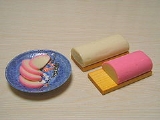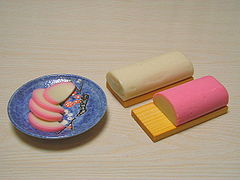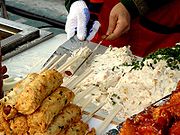
Kamaboko
Encyclopedia
is a type of cured
surimi
, a Japan
ese processed seafood
product, in which various white fish
are pureed, combined with additives such as MSG
, formed into distinctive loaves, and then steamed until fully cooked and firm. The steamed loaves are then sliced and served unheated (or chilled) with various dipping sauce
s or sliced and included in various hot soup
s, one-dish meals, or noodle
dishes. Kamaboko is typically sold in semicylindrical loaves. Some kamaboko include artistic patterns, such as the pink spiral on each slice of narutomaki
, named after the well-known tidal whirlpool near the Japanese city of Naruto
.
 Although the Japanese name for kamaboko is sometimes used outside of Japan (cf., sushi
Although the Japanese name for kamaboko is sometimes used outside of Japan (cf., sushi
), some extant English names for kamaboko are fish paste, fish loaf, fish cake, and fish sausage (Tsuji, 1980). Tsuji recommends using the Japanese name in English because no adequate English name exists, other than the Jewish dish, gefilte fish
, which is somewhat similar.
Red-skinned and white kamaboko are typically served at celebratory and holiday meals, as red and white are considered to bring good luck
.
Kamaboko has been made in Japan since the 14th century CE
and is now available nearly worldwide. The simulated crab meat product kanikama
(short for kani-kamaboko), the best-known form of surimi in the West, is a type of kamaboko. In Uwajima, a type of fried kamaboko called jakoten
is popular. In Japan, chīkama (cheese
plus kamaboko) is commonly sold in convenience stores as a pre-packaged snack food.
, red-skinned kamaboko is readily available in grocery stores. It is a staple of saimin
, a noodle soup popular in the state. Kamaboko is sometimes referred to as fish cake in Hawaii.
 In South Korea
In South Korea
, kamaboko is called either eomuk (Hangul
: , mixed
script: ) or odeng (오뎅, loan word from the Japanese oden
, a Japanese dish that sometimes contains kamaboko).
Eomuk can be boiled on a skewer in broth and is sold in street carts
where they can be eaten with alcoholic beverages, especially soju
, similar to the function of corn dog
stands. The broth is sometimes given to the customer in paper cups for dipping and drinking.
An alternate preparation of eomuk is sold in the colder times of the year and is marketed as 'Hotbar' or 'Hot Bar'. While the Hot Bar is still served on a stick or skewer, the recipe calls for deep frying instead of boiling. In this form, the Hot Bar can be prepared according to any particular vendor's 'secret' recipe: plain, mixed with vegetables such as diced carrot or whole perilla
leaf, or served with any number of sauces or condiments such as ketchup or mustard.
Curing (food preservation)
Curing refers to various food preservation and flavoring processes, especially of meat or fish, by the addition of a combination of salt, nitrates, nitrite or sugar. Many curing processes also involve smoking, the process of flavoring, or cooking...
surimi
Surimi
Surimi is a Japanese loan word referring to a fish-based food product that has been pulverized to a thick paste and has the property of a dense and rubbery food item when cooked...
, a Japan
Japan
Japan is an island nation in East Asia. Located in the Pacific Ocean, it lies to the east of the Sea of Japan, China, North Korea, South Korea and Russia, stretching from the Sea of Okhotsk in the north to the East China Sea and Taiwan in the south...
ese processed seafood
Seafood
Seafood is any form of marine life regarded as food by humans. Seafoods include fish, molluscs , crustaceans , echinoderms . Edible sea plants, such as some seaweeds and microalgae, are also seafood, and are widely eaten around the world, especially in Asia...
product, in which various white fish
Whitefish (fisheries term)
Whitefish or white fish is a fisheries term referring to several species of demersal fish with fins, particularly cod , whiting , and haddock , but also hake , pollock , or others...
are pureed, combined with additives such as MSG
Monosodium glutamate
Monosodium glutamate, also known as sodium glutamate or MSG, is the sodium salt of glutamic acid, one of the most abundant naturally occurring non-essential amino acids....
, formed into distinctive loaves, and then steamed until fully cooked and firm. The steamed loaves are then sliced and served unheated (or chilled) with various dipping sauce
Sauce
In cooking, a sauce is liquid, creaming or semi-solid food served on or used in preparing other foods. Sauces are not normally consumed by themselves; they add flavor, moisture, and visual appeal to another dish. Sauce is a French word taken from the Latin salsus, meaning salted...
s or sliced and included in various hot soup
Soup
Soup is a generally warm food that is made by combining ingredients such as meat and vegetables with stock, juice, water, or another liquid. Hot soups are additionally characterized by boiling solid ingredients in liquids in a pot until the flavors are extracted, forming a broth.Traditionally,...
s, one-dish meals, or noodle
Noodle
The noodle is a type of food, made from any of a variety of doughs, formed into long thin ribbons, strips, curly-cues, waves, helices, pipes, tubes, strings, or other various shapes, sometimes folded. They are usually cooked in a mixture of boiling water and/or oil. Depending upon the type, noodles...
dishes. Kamaboko is typically sold in semicylindrical loaves. Some kamaboko include artistic patterns, such as the pink spiral on each slice of narutomaki
Narutomaki
or is a type of kamaboko, or cured fish surimi produced in Japan. Each slice of naruto has a pink or red spiral pattern, which resembles the Naruto whirlpools in the Naruto Strait between Awaji Island and Shikoku in Japan.-Usage:...
, named after the well-known tidal whirlpool near the Japanese city of Naruto
Naruto, Tokushima
is a city in Tokushima Prefecture, Japan.In the quinquennial census of 2010, the city had a population of 61,522 . With a total area of the population density is 454 persons per km².The city was founded on March 15, 1947....
.

Sushi
is a Japanese food consisting of cooked vinegared rice combined with other ingredients . Neta and forms of sushi presentation vary, but the ingredient which all sushi have in common is shari...
), some extant English names for kamaboko are fish paste, fish loaf, fish cake, and fish sausage (Tsuji, 1980). Tsuji recommends using the Japanese name in English because no adequate English name exists, other than the Jewish dish, gefilte fish
Gefilte fish
Gefilte fish is a poached fish mince stuffed into the fish skin.More common since the Second World War are the Polish patties similar to quenelles or fish balls made from a mixture of ground deboned fish, mostly carp or pike...
, which is somewhat similar.
Red-skinned and white kamaboko are typically served at celebratory and holiday meals, as red and white are considered to bring good luck
Luck
Luck or fortuity is good fortune which occurs beyond one's control, without regard to one's will, intention, or desired result. There are at least two senses people usually mean when they use the term, the prescriptive sense and the descriptive sense...
.
Kamaboko has been made in Japan since the 14th century CE
Common Era
Common Era ,abbreviated as CE, is an alternative designation for the calendar era originally introduced by Dionysius Exiguus in the 6th century, traditionally identified with Anno Domini .Dates before the year 1 CE are indicated by the usage of BCE, short for Before the Common Era Common Era...
and is now available nearly worldwide. The simulated crab meat product kanikama
Crab stick
Crab sticks are a form of kamaboko, a processed seafood made of finely pulverized white fish flesh , shaped and cured to resemble crab leg meat....
(short for kani-kamaboko), the best-known form of surimi in the West, is a type of kamaboko. In Uwajima, a type of fried kamaboko called jakoten
Jakoten
is a special product of Uwajima in Southern Ehime prefecture. Jakoten has a long history, having been eaten since the Edo period. It is made from small fish caught nearby that are blended into a paste and then fried.-History:...
is popular. In Japan, chīkama (cheese
Cheese
Cheese is a generic term for a diverse group of milk-based food products. Cheese is produced throughout the world in wide-ranging flavors, textures, and forms....
plus kamaboko) is commonly sold in convenience stores as a pre-packaged snack food.
Kamaboko Day
The Kamaboko organization of Japan specified November 15 for Kamaboko Day in 1983.Hawaii
In HawaiiHawaii
Hawaii is the newest of the 50 U.S. states , and is the only U.S. state made up entirely of islands. It is the northernmost island group in Polynesia, occupying most of an archipelago in the central Pacific Ocean, southwest of the continental United States, southeast of Japan, and northeast of...
, red-skinned kamaboko is readily available in grocery stores. It is a staple of saimin
Saimin
Saimin is a noodle soup dish unique to Hawaii. Inspired by Japanese udon, Chinese mein, and Filipino pancit, saimin was developed during Hawaii's plantation era. It is a soup dish of soft wheat egg noodles served in hot dashi garnished with green onions...
, a noodle soup popular in the state. Kamaboko is sometimes referred to as fish cake in Hawaii.
South Korea

South Korea
The Republic of Korea , , is a sovereign state in East Asia, located on the southern portion of the Korean Peninsula. It is neighbored by the People's Republic of China to the west, Japan to the east, North Korea to the north, and the East China Sea and Republic of China to the south...
, kamaboko is called either eomuk (Hangul
Hangul
Hangul,Pronounced or ; Korean: 한글 Hangeul/Han'gŭl or 조선글 Chosŏn'gŭl/Joseongeul the Korean alphabet, is the native alphabet of the Korean language. It is a separate script from Hanja, the logographic Chinese characters which are also sometimes used to write Korean...
: , mixed
Hanja
Hanja is the Korean name for the Chinese characters hanzi. More specifically, it refers to those Chinese characters borrowed from Chinese and incorporated into the Korean language with Korean pronunciation...
script: ) or odeng (오뎅, loan word from the Japanese oden
Oden
Oden is a Japanese winter dish consisting of several ingredients such as boiled eggs, daikon radish, konnyaku, and processed fish cakes stewed in a light, soy-flavoured dashi broth. Ingredients vary according to region and between each household...
, a Japanese dish that sometimes contains kamaboko).
Eomuk can be boiled on a skewer in broth and is sold in street carts
Pojangmacha
Pojangmacha refers to small tented restaurants on wheels, or street stalls in South Korea which sell a variety of popular street foods such as hotteok, gimbap, tteokbokki, sundae, odeng, and anju . It literally means "covered wagon" in Korean...
where they can be eaten with alcoholic beverages, especially soju
Soju
Soju is a distilled beverage native to Korea. Its taste is comparable to vodka, though often slightly sweeter due to sugars added in the manufacturing process, and more commonly consumed neat.Most brands of soju are made in South Korea...
, similar to the function of corn dog
Corn dog
A corn dog is a hot dog sausage coated in a thick layer of cornmeal batter and deep fried in oil, although some are baked. Almost all corn dogs are served on wooden sticks, though some early versions had no stick.-History:...
stands. The broth is sometimes given to the customer in paper cups for dipping and drinking.
An alternate preparation of eomuk is sold in the colder times of the year and is marketed as 'Hotbar' or 'Hot Bar'. While the Hot Bar is still served on a stick or skewer, the recipe calls for deep frying instead of boiling. In this form, the Hot Bar can be prepared according to any particular vendor's 'secret' recipe: plain, mixed with vegetables such as diced carrot or whole perilla
Perilla
Perilla is the common name of the herbs of the genus Perilla of the mint family, Lamiaceae. In mild climates, the plant reseeds itself. There are both green-leafed and purple-leafed varieties, which are generally recognized as separate species by botanists. The leaves resemble stinging nettle...
leaf, or served with any number of sauces or condiments such as ketchup or mustard.
See also
- SurimiSurimiSurimi is a Japanese loan word referring to a fish-based food product that has been pulverized to a thick paste and has the property of a dense and rubbery food item when cooked...
, the raw product used to make kamaboko - ChikuwaChikuwais a Japanese tube-like food product made from ingredients such as fish surimi, salt, sugar, starch, monosodium glutamate and egg white. After mixing them well, they are wrapped around a bamboo or metal stick and steamed or broiled. The word chikuwa, comes from the shape when it is sliced.Variants...
, the bamboo-shaped kamaboko - Fish ballFish ballFish balls are a common food in southern China and overseas Chinese communities made from surimi . They are also common in Scandinavia, where they are usually made from cod or haddock.-Terminology:...
, the Chinese version of kamaboko

